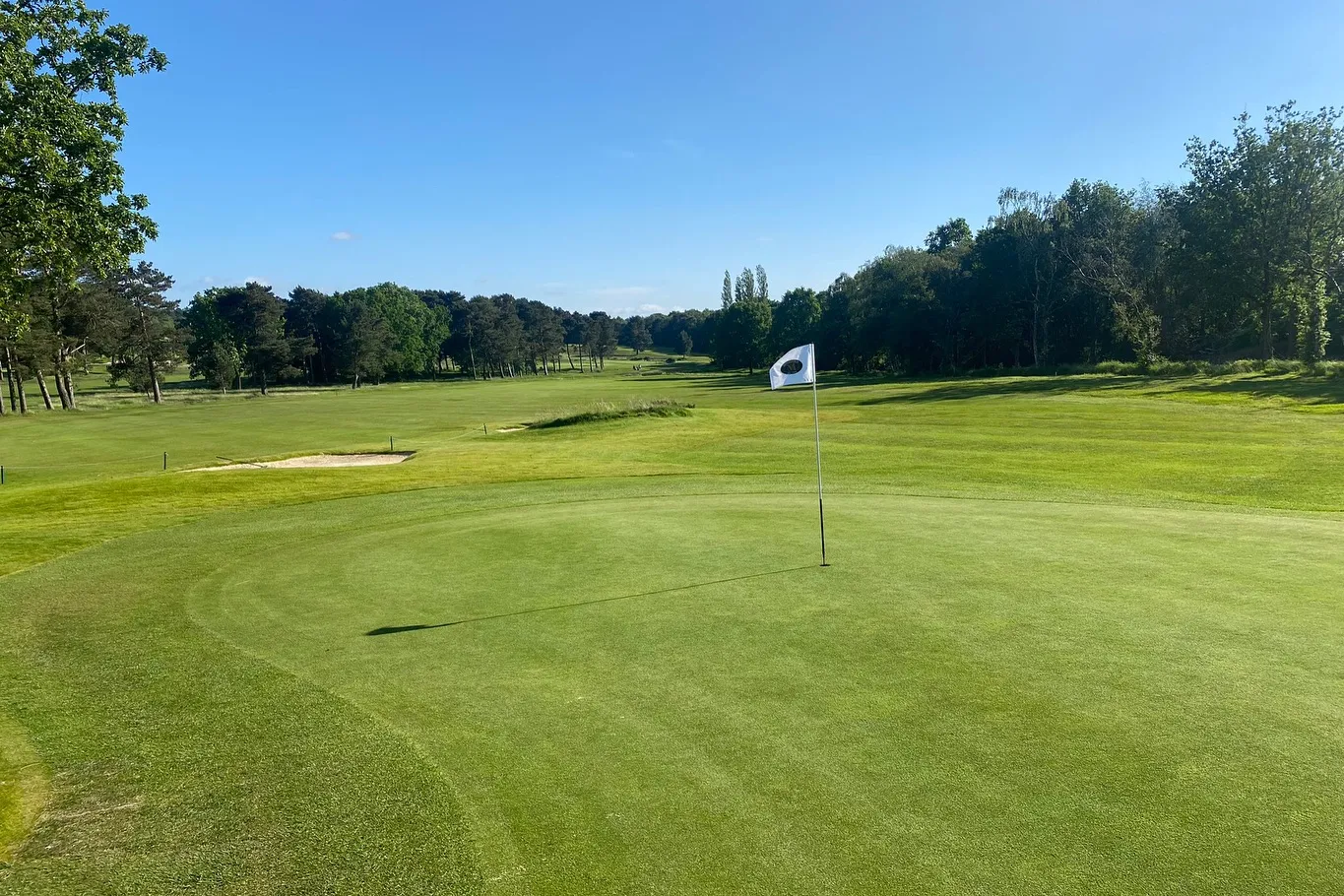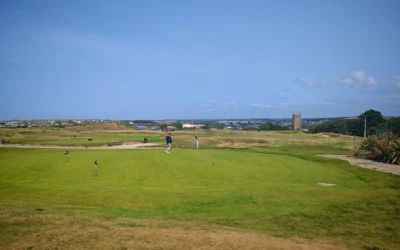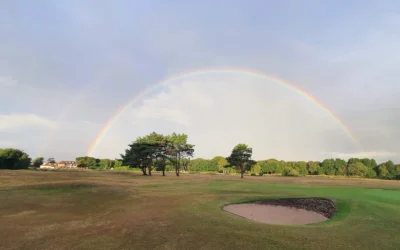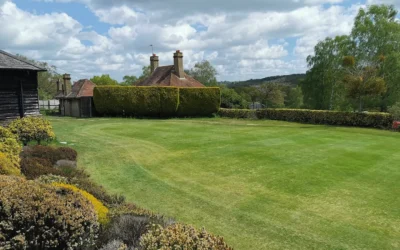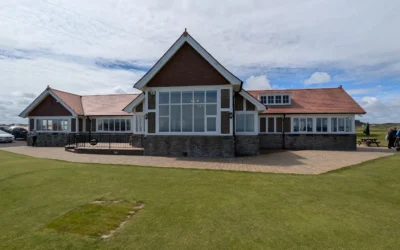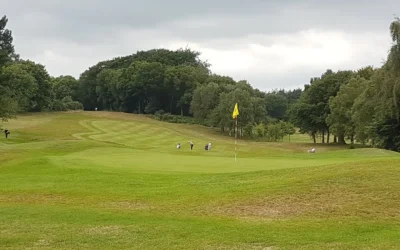Moortown Golf Club
Moortown Golf Club (Leeds, West Yorkshire, England)
Nestled in the rolling landscapes of West Yorkshire, Moortown Golf Club emerges as a beacon of golfing heritage and excellence. Crafted by the legendary Dr. Alister MacKenzie, whose genius also shaped Augusta National, this heathland masterpiece spans 175 acres of contrasting woodland and moorland. Since its founding in 1909, Moortown has captivated golfers with its challenging layout and scenic beauty. Its crowning moment came in 1929, hosting the first Ryder Cup on British soil, a historic event that etched its name in golfing lore.
Walking its fairways, where champions like Sir Nick Faldo and Danny Willett have competed, feels like stepping into a living museum of golf. Ranked among the UK’s top 100 courses, Moortown invites players to test their skills amidst a legacy that resonates with every swing.
Key Details
- Location: Alwoodley, Leeds, West Yorkshire, England
- Type: Heathland course
- Length: 7,001 yards (Blue tees)
- Par: 71
- Designers: Dr. Alister MacKenzie
- Established: 1909
- Notable Events: 1929 Ryder Cup, Yorkshire Evening News Tournament (1925–1962), Car Care Plan International (1984–1986)
History and Significance
In 1908, a visionary group laid the groundwork for Moortown Golf Club, selecting Black Moor, leased from the Lane-Fox estate, as its home. Dr. Alister MacKenzie, fresh from designing Alwoodley, was enlisted to craft the course. By 1909, the first holes were playable, with the full 18-hole layout soon completed. MacKenzie’s deep involvement—serving as Vice President in 1909 and Captain in 1913—ensured a design that married strategic brilliance with natural beauty. The club’s official opening in September 1910 featured a challenge match between golfing titans James Braid and Harry Vardon, postponed from May due to King Edward VII’s death, setting a prestigious tone.
Through the 1920s and 1930s, Moortown evolved under MacKenzie’s watchful eye, with his brother Charles refining the layout by the 1930s. The course’s bunkers, mimicking seaside contours, and its undulating greens distinguished it as a premier inland venue. By 1933, the Green Committee deemed further consultancy unnecessary, a testament to the enduring quality of MacKenzie’s work.
Moortown’s global prominence was sealed in 1929 when it hosted the second Ryder Cup, the first in Great Britain. Over 15,000 spectators braved challenging weather to witness Great Britain’s 7-5 victory over the USA. The course’s “perfect condition” and “beautiful greens” earned widespread acclaim, as noted in Golf Illustrated (May 3, 1929). This event, meticulously organized, left a lasting legacy, with the Ladies’ section still competing for a Ryder Cup trophy donated by Samuel Ryder. Moortown also hosted the Yorkshire Evening News Tournament 19 times (1925–1962), the Car Care Plan International (1984–1986), and prestigious amateur events like the English Amateur and Brabazon Trophy, as well as Open Championship qualifying rounds.
Today, Moortown stands as one of England’s finest inland courses, ranked 69th in the UK & Ireland by Golf Monthly in 2025. Its legacy, tied to luminaries like Sir Nick Faldo, Bernard Gallagher, Danny Willett, and Sir Michael Bonallack, continues to draw golfers worldwide. The club’s dedication to preserving its heritage ensures Moortown remains a cornerstone of golfing culture, blending history with modern excellence.
Course Features
Moortown Golf Club is a quintessential heathland course, stretching across 175 acres of lowland heathland where woodland and moorland intertwine. Dr. Alister MacKenzie’s design showcases large undulating greens, deep bunkers, heather, birch trees, burns, and bushes, creating a visually stunning yet formidable challenge. The fairways, deceptively inviting, are flanked by punishing rough and strategically placed bunkers that demand precision and thoughtful shot-making.
The course’s challenges are manifold: its 7,001-yard length from the Blue tees tests distance, while complex greens with subtle breaks require meticulous putting. Heathland winds add an unpredictable element, forcing golfers to adapt strategies on the fly. Recent enhancements, guided by architect Ken Moodie since 2014, have modernized the layout while honoring its heritage. The par-3 4th has been redesigned, new teeing grounds offer flexibility for various skill levels, and heather areas have been expanded to enhance the heathland aesthetic. Tree removal has unveiled sweeping vistas, making twilight rounds a visual delight despite the urban proximity.
Moortown’s holes offer remarkable variety, each seamlessly integrated with the natural terrain, a hallmark of MacKenzie’s philosophy. The peaty turf provides a firm, bouncy surface, rewarding run-up shots but punishing errors. Excellent drainage ensures playability even after rain, a testament to the course’s design and maintenance. As Golf Monthly notes, “It’s a tough and often unrelenting course due to its length and hazards, but it offers a good selection of teeing options… a thoroughly enjoyable heathland test.” Moortown’s blend of beauty, strategy, and challenge creates an unforgettable golfing experience.
Signature Holes
Hole 1 (Par 5, 486 yards)
The opening par-5 at Moortown sets an inviting yet strategic tone. Its generous fairway tempts aggressive drives, but bunkers and thick rough lurk to punish wayward shots. Positioning is key for a birdie opportunity, as the green is well-guarded. This hole introduces golfers to the course’s heathland charm, blending accessibility with subtle challenges that foreshadow the round ahead. Its design reflects MacKenzie’s knack for easing players into a course while hinting at the tests to come.
Hole 6 (Par 4, 446 yards)
Rated the toughest hole (Stroke Index 1), the 6th is a formidable par-4 that demands precision. The tee shot must navigate bunkers and dense rough, while the approach to a heavily guarded green tests accuracy under pressure. Recent redesigns have amplified its difficulty, making par a significant achievement. This hole epitomizes Moortown’s strategic depth, rewarding calculated play and cementing its reputation as a standout challenge.
Hole 10 (Par 3, 173 yards, “Gibraltar”)
The par-3 10th, known as “Gibraltar,” is Moortown’s signature hole, a MacKenzie masterpiece set on a rocky plateau. Its sloping green, flanked by deep bunkers, requires pinpoint accuracy, with any miscalculation severely punished. As the first hole constructed, it consumed the initial budget, underscoring its iconic status. MacKenzie claimed it as an original design, distinct from the Redan, and its dramatic setting and historical significance make it unforgettable.
Hole 18 (Par 4, 436 yards)
The closing par-4 is a dramatic dogleg right, climbing gently uphill to a well-protected green. Bunkers on the right and thick moorland rough on the left demand a precise tee shot, while the approach requires nerve to avoid hazards. Reviewers praise its memorability, with the clubhouse as a backdrop, making it a fitting finale that encapsulates Moortown’s blend of beauty and challenge.
Why Visit
Moortown Golf Club is a bucket-list destination for golfers, offering a rare blend of historical significance, strategic challenge, and natural beauty. Designed by Dr. Alister MacKenzie, the course tests every aspect of a golfer’s skill, from powerful drives to delicate putts. Its heathland layout, with large undulating greens and cunningly placed bunkers, provides a rigorous yet rewarding experience, with multiple teeing options ensuring accessibility for all skill levels. As Golf Monthly observes, “You’ll really feel as though you’ve been challenged… a thoroughly enjoyable heathland test.”
The emotional resonance of playing at Moortown is profound. As the 1929 Ryder Cup venue, it connects golfers to a storied past, where legends like Faldo and Willett have triumphed. Walking its fairways feels like a pilgrimage through golf’s history, with every hole steeped in legacy. A visitor shared on TripAdvisor, “Great MacKenzie course, sunny day, friendly welcome, excellent condition, recommended,” capturing the warmth and quality of the experience.
Beyond the course, Moortown’s facilities elevate the visit. The historic clubhouse, with its Samuel Ryder Lounge and MacKenzie Bar, offers a nostalgic retreat filled with memorabilia. The bar’s ambiance, coupled with excellent dining, ensures a memorable day. Another golfer noted, “Great course… staff offered free return voucher, enjoyed clubhouse,” highlighting the club’s hospitality. For those seeking challenge, history, and a warm welcome, Moortown delivers an unparalleled golfing journey.
Facilities
Moortown Golf Club’s facilities blend tradition with modern comfort, enhancing every visit. The clubhouse, meticulously maintained, is the heart of the club. The recently refurbished Samuel Ryder Lounge offers a spacious, contemporary setting for dining, ideal for group events or golf societies. It flows into a dining room accommodating larger gatherings, perfect for post-round celebrations or special occasions.
The MacKenzie Bar is the clubhouse’s centerpiece, exuding history with golfing memorabilia, trophies, and photography. It’s a cozy spot for a coffee before teeing off or a drink to recount the day’s highlights. Outdoor seating, including the iconic ‘benches’ at the 18th hole and a new glass-fronted terrace added in 2022, provides stunning course views, enhancing the relaxation experience.
For inclement weather, a Snooker Room offers entertainment, though the course’s excellent drainage ensures rare closures. Complimentary warm-up areas, praised as “excellent,” allow golfers to prepare thoroughly, rounding out a comprehensive and luxurious visit.
Contact Details and Directions
- Address: Harrogate Road, Alwoodley, Leeds, LS17 7DB, United Kingdom
- Phone: +44 (0)113 268 6521
- Email: secretary@moortown-gc.co.uk
- Directions:
- From Leeds City Center: Take A61 north towards Harrogate (5 miles). Club is past Shell Petrol Station, ½ mile north of A6120.
- From Leeds Bradford Airport: Drive 7 miles via A658 to A61 south; follow signs.
- Public Transport: Leeds Station; taxis or buses to Alwoodley.
- Parking: Ample on-site parking.
- Map: View on Google Maps
Green Fees and Booking
Green fees at Moortown vary by season, reflecting its premium status:
|
Season |
Fee (£) |
|
December–February |
85.00 |
|
March |
100.00 |
|
April |
150.00 |
|
May |
175.00 |
|
June–September |
200.00 |
|
October |
150.00 |
|
November–February |
100.00 |
Tee times can be booked online at BRS Golf or by calling +44 (0)113 268 6521. Groups of 12 or more, or GB&I Golf Club Members with WHS Numbers, may access preferential rates via the contact form. Smart golf attire is mandatory; review the dress code and safety guidelines.
Nearby Attractions
West Yorkshire’s rich tapestry of attractions enhances a visit to Moortown, offering history, nature, and culture for golfers and companions alike. Leeds, a vibrant city, provides a perfect backdrop for exploration.
|
Attraction |
Appeal |
Approx. Distance |
|
Roundhay Park |
Urban park with gardens, lakes |
3 miles |
|
Tropical World |
Exotic animals and plants |
3 miles |
|
Golden Acre Park |
Scenic gardens and lake |
4 miles |
|
Temple Newsam |
Historic house and farm |
7 miles |
|
Harewood House |
Stately home and bird garden |
5 miles |
|
Kirkstall Abbey |
12th-century monastery ruins |
6 miles |
|
Leeds City Museum |
Local history and archaeology |
5 miles |
|
Royal Armouries Museum |
Arms and armor collection |
6 miles |
|
Thackray Museum |
Medical history exhibits |
4 miles |
- Roundhay Park: One of Europe’s largest city parks, its lakes, woodlands, and manicured gardens offer serene walks and picnic spots, ideal for relaxation.
- Tropical World: Nestled in Roundhay Park, this attraction features butterflies, meerkats, and tropical plants, providing an educational and fun outing for families.
- Golden Acre Park: With serene gardens, a tranquil lake, and walking trails, this park is a haven for those seeking nature’s calm.
- Temple Newsam: A Tudor-Jacobean estate with a rare breeds farm and expansive grounds, perfect for history enthusiasts and families.
- Harewood House: An 18th-century mansion boasting art collections, lush gardens, and a bird garden, offering a glimpse into aristocratic life.
- Kirkstall Abbey: The picturesque ruins of a 12th-century Cistercian monastery provide historical insights and a peaceful retreat.
- Leeds City Museum: Located in the city center, it showcases Leeds’ history from ancient times to the present through engaging exhibits.
- Royal Armouries Museum: This museum houses the UK’s collection of arms and armor, captivating history buffs with its displays.
- Thackray Museum: Near St James’s Hospital, it explores the history of medicine, offering interactive exhibits for curious visitors.
Frequently Asked Questions (FAQs)
How do I book a tee time at Moortown Golf Club?
Book online at BRS Golf or call +44 (0)113 268 6521 for reservations.
What are the green fees?
Fees range from £85 (winter) to £200 (summer). Visit Moortown Visitors for current rates.
Is there a dress code?
Smart golf attire is required. Check the dress code for specifics.
Are there practice facilities?
Yes, complimentary warm-up areas are available for golfers to prepare.
Can I hire a caddy?
Contact the club at +44 (0)113 268 6521 to inquire about caddy availability.
What is the course par?
Par 71 for men, par 75 for women, offering a balanced challenge.
How long is the course?
The course measures 7,001 yards from the Blue tees.
Who designed the course?
Dr. Alister MacKenzie, also known for designing Augusta National.
What major events has the course hosted?
Notable events include the 1929 Ryder Cup and Yorkshire Evening News Tournament.
Is the course open to visitors?
Yes, visitors are welcome; advance booking is recommended.
Are there membership options?
Various memberships are available; email secretary@moortown-gc.co.uk for details.
What facilities does the clubhouse offer?
Features include the Samuel Ryder Lounge, MacKenzie Bar, and Snooker Room.
Is there accommodation on site?
No, but Leeds offers numerous hotels nearby for visitors.
What is the best time to play?
Summer (June–September) offers optimal weather, though the course is open year-round.
Are there nearby golf courses?
Alwoodley and Sand Moor Golf Clubs are within close proximity.
West Cornwall Golf Club
West Cornwall Golf Club (Lelant, St. Ives, Cornwall, England) Imagine teeing off with the Atlantic Ocean shimmering in the distance, the historic St Uny’s Church framing your shot, and the legacy of golfing greats like Jim Barnes inspiring your swing. West Cornwall...
Fairhaven Golf Club
Fairhaven Golf Club (Lytham, Lancashire, England) Tucked away in the heart of Lancashire’s famed “Golf Coast,” Fairhaven Golf Club is a hidden gem that blends over 125 years of golfing heritage with a captivating mix of links and parkland golf. Set within the tranquil...
Reigate Heath Golf Club
Reigate Heath Golf Club (Reigate, Surrey, England) Imagine teeing off on a crisp Surrey morning, surrounded by heather and gorse, with an 18th-century windmill standing sentinel nearby. Reigate Heath Golf Club, nestled in the heart of Surrey’s rolling countryside,...
Bamburgh Castle Golf Club
Bamburgh Castle Golf Club (Bamburgh, Northumberland, England) Perched on the dramatic clifftops of Northumberland’s coast, Bamburgh Castle Golf Club is a hidden gem that blends exhilarating golf with some of the most breathtaking scenery in England. As you stand on...
Sandiway Golf Club
Sandiway Golf Club (Cheshire, England) Nestled in the heart of Cheshire’s rolling countryside, Sandiway Golf Club stands as a testament to golfing excellence and tradition. Established in 1920, this prestigious course was crafted by legendary architects, including Ted...
